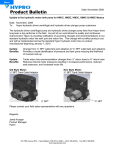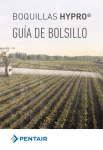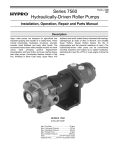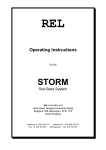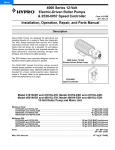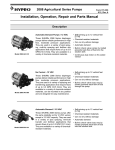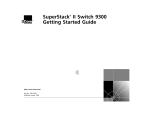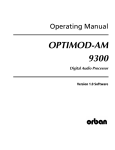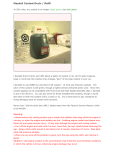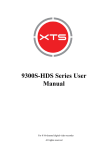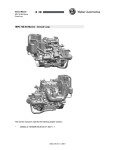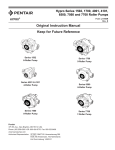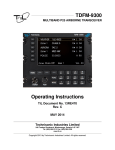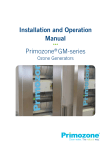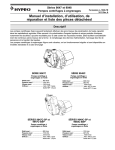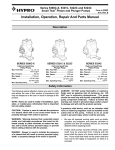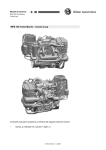Download 9307 Series User Manual
Transcript
Menu Series 9307 Hydraulically-Driven Centrifugal Pumps Installation, Operation, Repair and Parts Manual Form L-1492 12/10 Description Hypro centrifugal pumps are designed for agricultural and industrial spraying and transfer of a variety of fluids: water, insecticides, herbicides, wettable powders, emulsives, liquid fertilizers, etc. Hypro Series 9307 hydraulic motor-driven centrifugal pumps provide smooth performance. They can be conveniently mounted on the tractor or sprayer, becoming part of the vehicle’s hydraulic system and freeing the PTO for other uses. SERIES 9307 Hydraulically-Driven Centrifugal Pumps Max. Flow Rate: ..................370 gpm Max. Pressure: ....................135 psi Ports: ...3" NPT or 300 Universal Inlet ..........2" NPT or 220 Universal Outlet Hydraulic Ports: ..........7/8" SAE Inlet ..............................1-1/16" SAE Outlet General Safety Information Notes are used to notify of installation, operation, or maintenance information that is important but not safety related. Caution is used to indicate the presence of a hazard, which will or may cause minor injury or property damage if the notice is ignored. Warning denotes that a potential hazard exists and indicates procedures that must be followed exactly to either eliminate or reduce the hazard, and to avoid serious personal injury, or prevent future safety problems with the product. Danger is used to indicate the presence of a hazard that will result in severe personal injury, death, or property damage if the notice is ignored. Do not pump flammable or explosive fluids such as gasoline, fuel oil, kerosene, etc. Do not use in explosive atmospheres. Components not rated for use with Anhydrous Ammonia. The pump should be used only with liquids compatible with the pump component materials. Failure to follow this notice may result in severe personal injury and/or property damage and will void the product warranty. 1. Do not pump at pressures higher than the maximum recommended pressure. 2. Maximum liquid temperature is 140o F for Series 9307 centrifugal pumps. 3. Disconnect power before servicing. 4. Release all pressure within the system before servicing any component. 5. Drain all liquids from the system before servicing any component. Flush with water. 6. Secure the outlet lines before starting the pump. An unsecured line may whip, causing personal injury and/or property damage. 7. Check hose for weak or worn condition before each use. Make certain that all connections are tightly secured. 8. Periodically inspect the pump and the system components. Perform routine maintenance as required (See Repair Instructions). 9. Use only pipe, hose and fittings rated for the maximum psi rating of the pump. 10. Do not use these pumps for pumping water or other Hazardous Substance Alert 1. Always drain and flush pump before servicing or disassembling for any reason. 2. Always drain and flush pumps prior to returning unit for repair. 3. Never store pumps containing hazardous chemicals. 4. Before returning pump for service/repair, drain out all liquids and flush unit with neutralizing liquid. Then, drain the pump. Attach tag or include written notice certifying that this has been done. It is illegal to ship or transport any hazardous chemicals without United States Environmental Protection Agency Licensing. L-1492 (12/10) Never use your hand to check the condition of hydraulic lines or hoses. If hydraulic fluid penetrates the skin, get medical help immediately. Failure to get proper medical help may result in loss of limb or life. The safest way to check hydraulic lines or hoses is by holding a piece of cardboard next to the hydraulic line or hose. The sound pressure level of the pump is 80dBA. Observe all safety precautions when operating the pump within close proximity for extended periods of time by wearing hearing protectors. Extended exposure to elevated sound levels will result in permanent loss of hearing acuteness, tinnitus, tiredness, stress, and other effects such as loss of balance and awareness. -2- Plumbing Installation 6 7 Figure 1 Centrifugal Plumbing Hook-up REF. NO. 1 2 3 4 5 6 7 8 9 10 -3- DESCRIPTION Tank Lid Vent Line #3430-0456 Jet Agitator Shut-off Ball Valves Centrifugal Pump Spray Control Console Centrifugal Pump Control Manifold Boom Valve Electromagnetic Flowmeter Compact Jet Turret Nozzle Body L-1492 (12/10) Installation Instructions Preliminary to Mounting Consult the owners manual to determine the type and capacity of the hydraulic system. Make sure the hydraulic system is recommended to operate with a continuous load. Refer to the Pump Selection Guide to confirm you have the proper pump for your hydraulic system. Check to see that the pump impeller can be turned by hand. (Turn the shaft clockwise using a deep socket wrench on the impeller nut.) If it cannot be turned, open the pump casing to look for obstructions. Clean out any corrosion build up where the casing fits over the eye of the impeller. Pump Inlet Line To achieve full capacity from the pump, the inlet line should be at least the same size as the inlet port on the pump. Reducing this line size will restrict the capabilities of the pump. The line must also be free of air leaks. Check all fittings and connections in the suction line for tightness. The introduction of air may affect the priming and pumping capabilities of the pump. Use good quality suction hose that will not be collapsed by suction. For non self-priming models, the centrifugal pump should be mounted below the liquid level and as near to the liquid source as possible to allow for the shortest suction line practical. To achieve optimal performance, the suction line should slope down into the pump. Avoid rises and humps that could trap air in the line to the pump. The suction line and pump should be filled with liquid prior to starting the pump, and all discharge lines should be open. Pump Outlet Line The recommended orientation for the outlet port is pointing straight up. This allows liquid to stay in the pump while it is priming. The outlet line should be the same size as the pressure port on the pump to give the optimal flow. The line should have as few restrictions and elbows as possible to optimize the pump performance and reduce pressure drop from the pump to the spray tips. Priming the Pump The Pump must not be run dry. Before starting the pump, the inlet line and pump must be filled with liquid and all discharge lines must be open. On self-priming models, only the pump chamber needs to be filled with liquid. The pump must not be run unless it is completely filled with liquid because there is a danger of damaging the mechanical seal, which depends on the liquid for its lubrication. Non-self-priming models should be mounted below the level of the liquid. The suction line should slope down to the pump and be free of dips and bends. If this cannot be done, a foot valve should be installed in the end of the inlet line so that the line can be completely filled with liquid before starting the pump. For best priming results, the top vent plug should be removed from the pump casing, and a vent line (1/4" [ 6.35 mm] tubing is sufficient) should be installed running back to the top of the tank. This line prevents air lock and allows the pump to prime itself by bleeding off trapped air. The small L-1492 (12/10) stream of liquid that returns to the tank during operation is negligible. The discharge from this line should be positioned in the tank above the high liquid level. Self-priming models can be primed by removing the top vent plug and filling the priming chamber. The priming chamber will fill to the level of the inlet port. After use, the priming chamber should be flushed and drained to avoid chemical corrosion and damage from freezing. Drain by removing the lower drain plug. Controlling the Pump Flow The best way to control the flow is by incorporating two control valves in a pipe tee immediately after the strainer in the discharge line. This permits controlling agitation flow independently of nozzle flow. In any centrifugal pump, it is the large volume of liquid which puts load on the drive. Use only the flow needed to develop the pressure required at the boom and to maintain adequate agitation. Hydraulic motor-driven centrifugal pumps are easily adjusted to the exact flow required, as explained in the Operating Instructions of this manual. Centrifugal Pump Control Hypro now offers many different components for spraying systems. The Hypro centrifugal pump control incorporates the electric flow control valve, a self-cleaning line strainer, a visual pressure gauge and a manual agitation control valve. Flow Control Valve A high-flow electric proportional valve allows for maximum flow control to the boom valves. It provides smooth, rapid control that can be controlled from either an electronic rate controller or switch box. Strainers The recommended placement of the strainer for a centrifugal pump is in the pump outlet line. This will eliminate any possible restriction that the strainer could create if it were installed in the inlet line. Ensure that the proper strainer size and screen mesh are used to limit the pressure drop and achieve the best filtration. Line strainers can also be installed in the tank fill line to filter liquid as it is loaded into the tank as well as in the boom lines to further filter the solution prior to the spray tips. Tank baskets can also be used to filter material added through the tank lid. Agitation The centrifugal pump control contains a manual agitation control valve that can be adjusted to provide the right amount of flow to the jet agitators in the tank to ensure proper mixing within the tank. Flowmeter To eliminate the mechanical problems of a turbine flowmeter, we recommend that an electromagnetic flowmeter be used. These flowmeters have no moving parts to wear out and will provide a more consistent and accurate flow reading. They can be input into just about any electronic rate controller or switch box. Boom Section Valves For rapid response and reliability, we recommend electric plunger valves be used for boom control. The valves -4- Plumbing Installation should be sized accordingly to minimize the pressure drop and maximize the flow rate. The boom tubing or hose should be sized accordingly to ensure that a pressure drop in the lines does not occur, causing inconsistent pressures at the nozzles. Nozzle Bodies Nozzle bodies with shut-off check valves are recommended to eliminate dripping from the spray tips when the boom valves are shut down. Hooking Up the Hydraulic Motor to the Tractor Hydraulic System Hypro Series 9300HMC hydraulic motor-driven pumps can be mounted on either the tractor or sprayer. When hooking up, make sure that no dirt or liquid gets into the hydraulic motor. Keep all hydraulic connections clean. Be sure to connect the hydraulic motor into the system correctly by putting the pressure line to the (IN) Port and return line to the (OUT) Port. For maximum performance, the hydraulic lines should also be at least 3/4" [19 mm] in size. Standard spool valves, which are found on all tractor hydraulic systems, may cause potentially damaging high peak pressures in the hydraulic system when closed because of abrupt shut-off of oil flow in both the supply and return lines. When shutting off the pump, move the selector to the FLOAT position to allow the centrifugal pump to come to a stop gradually. For further information regarding Hypro products, contact your local dealer or Hypro directly at www.hypropumps.com or by calling 1-800-424-9776. Operation Open Center Systems— All Models Adjusting Centrifugal Pump Output 1. Start the tractor. Leave the directional valve in the neutral position and allow hydraulic oil to circulate for approximately 10 to 15 minutes or until adequately warmed. 2. Prime the centrifugal pump with all valves open (See the Installation Instructions and System Configuration Diagram). 3. Close the agitation line valve and keep the control valve and the boom shut-off valve open. Note the spray pressure. 4. Open the agitation line valve until you have desired circulation in the tank. Recheck the spray pressure. If it is too low, close down the agitation line valve until the desired spray pressure is reached. If the spray pressure is too high, throttle the centrifugal pump by closing down the control valve. Closed Center (Load Sensing) — All Models Many tractors are being introduced with load sensing systems (also referred to as flow and pressurecompensated systems) which simplify system setup and eliminate many of the problems associated with using the wrong size pump motors on a given hydraulic system. Usually, any of Hypro’s 9300HMC models may be used on this type of system, provided the hydraulic system produces sufficient oil flow for the hydraulic motor being used (Refer to the Pump Selection Guide). This system maintains a constant flow of hydraulic oil for a given pressure drop. The flow is adjustable with a flow control valve installed in the hydraulic system (such as the Tortoise/Hare control on John Deere tractors). Because this system has adjustable flow, there is no need to bypass hydraulic oil as in an open center system, or to restrict the flow with orifices as in a closed center pressurecompensated system. -5- Adjusting Centrifugal Pump Output 1. Set the tractor hydraulic flow control valve for minimum hydraulic oil flow to the remote outlet (Tortoise position). 2. Start the tractor and allow the hydraulic oil to circulate for approximately 10 to 15 minutes or until adequately warmed. 3. Prime the centrifugal pump with all valves open (See the Installation Instructions and System Configuration Diagram). 4. Close the agitation line valve and open the control valve and the boom shut-off valve. 5. Slowly adjust the tractor hydraulic flow control valve until the desired boom pressure is attained. 6. Open the agitation line valve until sufficient agitation is observed. If spray pressure drops, readjust the tractor hydraulic flow control valve to restore it to the desired pressure. Flush Pump After Use One of the most common causes for faulty pump performance is gumming or corrosion inside the pump. Flush the pump and entire system with a solution that will chemically neutralize the liquid pumped. Mix this solution according to the manufacturer’s directions. This will dissolve most residue remaining in the pump, leaving the inside of the pump clean for the next use. To Prevent Corrosion After cleaning the pump as directed above, flush it with a permanent-type automobile antifreeze (Prestone®, Zerex®, etc.) containing a rust inhibitor. Use a 50% solution, half antifreeze and half water, or fill the pump with FLUID FILM® and then drain it. A protective coating of FLUID FILM® will remain on the inner pump surfaces. Save the excess FLUID FILM® for the next application. Plug the ports to keep out air during storage. For short periods of idleness, noncorrosive liquids may be left in the pump, but air must be kept out. Plug the ports or the seal port connections. L-1492 (12/10) Repair Instructions Pump Housing Disassembly 1. Using a 3/4" wrench, remove the eight Hex Head Bolts holding the Pump Casing to the Mounting Flange. Once removed, turn the cover until mounting holes are exposed. Place a screwdriver on each side of the cover and pry away the mounting flange (See Figure 2). Pump Seal Removal 1. Lightly lubricate the shaft for easier removal of the seal. Using two screwdrivers positioned opposite each other, pry the rotary portion of the seal from the shaft (See Figure 5). Figure 5 Figure 2 2. To remove the Impeller Nut, insert a large screwdriver or file (at least 10" [254 mm] long) into Impeller Vanes to prevent Impeller from turning when loosening nut. Use a 1-1/16" socket wrench to remove the Impeller Nut by turning it counterclockwise (See Figure 3). 2. Lift the seal flange off of the mounting flange. Use screwdrivers to pry loose, if necessary. 3. Using a screwdriver and hammer, tap out the stationary portion of the mechanical seal from the motor side of the seal flange. The seal will be damaged by removal in this manner. A new seal must be used when pump is reassembled. In the case of a severe pump seal leak, inspect the shaft/bearing assembly for possible contamination. Clean-Up Of Pump Housing Figure 3 3. Once nut [and washer] is removed, place a screwdriver on each side behind the Impeller and pry away from the Mounting Flange (See Figure 4). Remove Key from the Shaft. Remove O-ring from the Mounting Flange. 1. Using a circular bottle-type wire brush with air or hand drill, clean the outlet port, inlet port and the sealing areas of the o-ring on the pump casing and seal flange. Using the port brush, clean the seal cavity in the mounting flange. 2. After wire brush cleaning, it is recommended that the pump casing and seal flange be further cleaned in a solvent tank to remove rust and corrosion particles. Bearing Removal 1. Using a 9/16” wrench, remove the two motor mounting bolts. Lift the hydraulic motor from the mounting flange. 2. Remove slinger from shaft. Use a screwdriver to pry and guide the snap ring out of the mounting flange (See Figure 6). Figure 4 L-1492 (12/10) -6- 4. Spread the snap ring by grabbing the open ends and pulling them apart, like extending a spring. Guide the retaining ring into the mounting flange using a screwdriver for assistance (See Figure 9). Figure 6 3. Set the mounting flange shaft side down in a press to remove the bearing and shaft assembly (See Figure 7). Figure 9 5. Install the slinger onto the pump shaft. 6. Using soap and water as a lubricant, install the stationary half of the mechanical seal into the seal flange. Press it into place using a rag over the seal face and a 1-3/8” plastic guide (See Figure 10). Assemble the seal flange and mechanical seal. Assemble onto the mounting flange, taking care to avoid hitting the mechanical seal on the pump shaft. Figure 7 4. Support the bearings only in a press to remove from the shaft. Use a snap ring pliers to remove retaining rings, if necessary (See Figure 8). Figure 10 7. Install the rotary portion of the mechanical seal onto the pump shaft, using soap and water as a lubricant. 8. Place the impeller, washer and a cover nut onto the pump shaft. Use medium strength thread locker on the acorn nut. Torque to 80 ft.-lbs. using a 1-1/16” socket. Figure 8 Pump Assembly 1. Assemble the retaining rings to the pump shaft, using a snap ring pliers. 2. Press the bearings onto the pump shaft using a press. 3. Using a press, install the pump shaft and bearing assembly into the mounting flange. -7- 9. Install the o-ring in the pump casing, lubricate the o-ring with soap and water. Place the pump casing on the mounting flange. Flip the assembly over onto the inlet part of the pump casing. Install the casing bolts with medium strength thread locker and torque to 75 ft.-lbs. using a 3/4” wrench. 10. Apply anti-seize to the hydraulic motor shaft. Place the hydraulic motor onto the pump assembly. Apply medium strength thread locker to the motor mounting bolts, torque to 25 ft.-lbs. using a 9/16” wrench. L-1492 (12/10) Hydraulic Motor Seal Disassembly Instructions 1. Clamp the motor in a vise with the bolts facing up. Take caution to avoid damaging the machined surfaces of the motor. Remove the bolts using a 17 mm wrench. See Figure 1. 2. Remove the rear cover of the motor. Mark the balancing plate and body to ensure proper reassembly. See Figure 2. Remove the balancing plate for seal replacement. Place the rear cover back on the motor. 3. Remove the motor from the vise and set it on the rear cover. Remove the front cover. Mark the balancing plate and body to ensure proper reassembly. See Figure 2. Remove the balancing plate for seal replacement. Remove the drive and driven gear. Inspect all components for worn parts. If non-seal components are worn, replace motor assembly. Figure 1 4. Remove snap ring and support ring. Punch shaft seal out using a screwdriver and soft mallet. Assembly Instructions 5. Place shaft seal in front cover, spring side down, followed by the support ring and snap ring. 6. Place rear balancing plate in the body, making sure there is proper alignment. Place drive gear and driven gear in the body and rear balancing plate. Set the front balancing plate over the shafts and into the body. Thoroughly grease the splines of the drive shaft before placing the front cover on the body, pressing onto the guide pins. 7. Rotate the pump and reclamp in a vise. Set the rear cover over the guide pins. Install bolts and torque to 44 in.-lbs. Model 2500-0046 only L-1492 (12/10) -8- Figure 2 Troubleshooting If the proper Hydraulic Pump Unit has been selected according to Hypro recommendations, and the unit has been correctly plumbed into the hydraulic system, operation should be quite satisfactory. If spraying performance is unsatisfactory Symptom Probable Cause(s) Low Discharge Pump not primed. Troubleshooting Guide Air leaks in inlet line. Blocked or clogged line strainer. Impeller plugged. Undersize inlet line or collapsed hose. Improperly sized hydraulic motor. Hydraulic system overheating or hydraulic system heat is excessive etc., check the following troubleshooting guide for possible problems and solutions. Corrective Action(s) — Remove topmost vent plug from face of pump and run pump to expel trapped air (See Installation Instructions). — Check and reseal inlet fittings. — Inspect strainer and clear any debris from screen. — Inspect and clear obstruction. — Suction line should be the same diameter as inlet port of pump or larger. — Eye of impeller rubbing on volute. — Improper hydraulic motor size. — Insufficient hydraulic hose size. — Refer to Pump Selection Guide to determine proper size hydraulic motor for your hydraulic system. Remove volute (front cover) and inspect the impeller. If wear detected, sand the impeller eye O.D. with emery cloth. Refer to Pump Selection Guide to determine proper size for your hydraulic system. Check hydraulic hose size. Hose should be at least 1/2" [12.7 mm]. For large open-center systems, 3/4" [19.05 mm]. -9- L-1492 (12/10) Performance Charts L-1492 (12/10) -10- Models 9307C-GM10, 9307C-GM12, 9307C-GM10-U & 9307C-GM12-U 18 17 20 16 15 13 12 21 19 14 11 10 8 1 Mechanical Seal Kit #3430-0604 Includes Items 7 & 8 4 2 3 6 9 7 5 Bearing Kit #3430-0671 Includes Items 10, 11, 12, 13 & 15 Impeller Hardware Kit #3430-0612 Includes Items 3, 4 & 6 NOTE: When ordering parts, give quantity, part number, description and complete model number. Reference numbers are used ONLY to identify parts in the drawing and are NOT to be used as order numbers. Hydraulic Motor Seal Replacement #3430-0611 For seal replacement in Motor #2500-0036 (GM10) Hydraulic Motor Seal Replacement #3430-0616 For seal replacement in Motor #2500-0046 (GM12) Ref. Qty. Description No. Req'd Part No. Ref. Qty. Description 1* 1 0150-9300C No. Req'd Part No. Pump Casing 1** 1 0151-9300C Pump Casing (Universal Flange) 12 1 2005-0006 Double Row Ball Bearing 2 4 2406-0039 Pipe Plug 13 2 1810-0001 Retaining Ring 3 1 2253-0010 Acorn Nut 14 1 0500-9305 Shaft Assembly 4 1 2270-0094 Washer 15 1 2007-0063 Ball Bearing 5 1 0400-9300S Impeller 16 1 0757-9300C Mounting Flange 6 1 1610-0058 Key 17 1 1720-0209 O-Ring 7 1 1721-0208 O-Ring 18 1 2300-0040 Plug 8 1 2120-0043 Mechanical Seal 19 8 2210-0131 Bolt 9 1 0755-9300C Seal Flange 20 2 2210-0026 Bolt 10 1 2270-0093 Slinger 21 1 2500-0036 Hydraulic Motor (GM10) 11 1 1820-0040 Retaining Ring 21 1 2500-0046 Hydraulic Motor (GM12) *Includes a Stainless Steel Wear Ring and 4 Pipe Plugs (Ref. No. 2) **Used in -U "Universal Flange" models, includes Stainless Steel Wear Ring and 4 Pipe Plugs (Ref. No. 2) -11- L-1492 (12/10) Limited Warranty on Hypro/SHURflo Agricultural Pumps & Accessories Hypro/SHURflo (hereafter, “Hypro”) agricultural products are warranted to be free of defects in material and workmanship under normal use for the time periods listed below, with proof of purchase. - Pumps: one (1) year from the date of manufacture, or one (1) year of use. This limited warranty will not exceed two (2) years, in any event. - Accessories: ninety (90) days of use. This limited warranty will not apply to products that were improperly installed, misapplied, damaged, altered, or incompatible with fluids or components not manufactured by Hypro. All warranty considerations are governed by Hypro’s written return policy. Hypro’s obligation under this limited warranty policy is limited to the repair or replacement of the product. All returns will be tested per Hypro’s factory criteria. Products found not defective (under the terms of this limited warranty) are subject to charges paid by the returnee for the testing and packaging of “tested good” non-warranty returns. No credit or labor allowances will be given for products returned as defective. Warranty replacement will be shipped on a freight allowed basis. Hypro reserves the right to choose the method of transportation. This limited warranty is in lieu of all other warranties, expressed or implied, and no other person is authorized to give any other warranty or assume obligation or liability on Hypro’s behalf. Hypro shall not be liable for any labor, damage or other expense, nor shall Hypro be liable for any indirect, incidental or consequential damages of any kind incurred by the reason of the use or sale of any defective product. This limited warranty covers agricultural products distributed within the United States of America. Other world market areas should consult with the actual distributor for any deviation from this document. Return Procedures All products must be flushed of any chemical (ref. OSHA section 1910.1200 (d) (e) (f) (g) (h)) and hazardous chemicals must be labeled/tagged before being shipped* to Hypro for service or warranty consideration. Hypro reserves the right to request a Material Safety Data Sheet from the returnee for any pump/product it deems necessary. Hypro reserves the right to “disposition as scrap” products returned which contain unknown fluids. Hypro reserves the right to charge the returnee for any and all costs incurred for chemical testing, and proper disposal of components containing unknown fluids. Hypro requests this in order to protect the environment and personnel from the hazards of handling unknown fluids. Be prepared to give Hypro full details of the problem, including the model number, date of purchase, and from whom you purchased your product. Hypro may request additional information, and may require a sketch to illustrate the problem. Contact Hypro Service Department at 800-468-3428 to receive a Return Merchandise Authorization number (RMA#). Returns are to be shipped with the RMA number clearly marked on the outside of the package. Hypro shall not be liable for freight damage incurred during shipping. Please package all returns carefully. All products returned for warranty work should be sent shipping charges prepaid to: HYPRO Attention: Service Department 375 Fifth Avenue NW New Brighton, MN 55112 For technical or application assistance, call the Hypro Technical/Application number: 800-445-8360. To obtain service or warranty assistance, call the Hypro Service and Warranty number: 800-468-3428; or send a fax to the Hypro Service and Warranty FAX: 651-766-6618. *Carriers, including U.S.P.S., airlines, UPS, ground freight, etc., require specific identification of any hazardous material being shipped. Failure to do so may result in a substantial fine and/or prison term. Check with your shipping company for specific instructions. Hypro 2010 Printed in USA SPRAY & INJECTION TECHNOLOGIES GROUP 375 Fifth Avenue NW • New Brighton, MN 55112 Phone: (651) 766-6300 • 800-424-9776 • Fax: 800-323-6496 w w w. h y p r o p um p s . c o m












